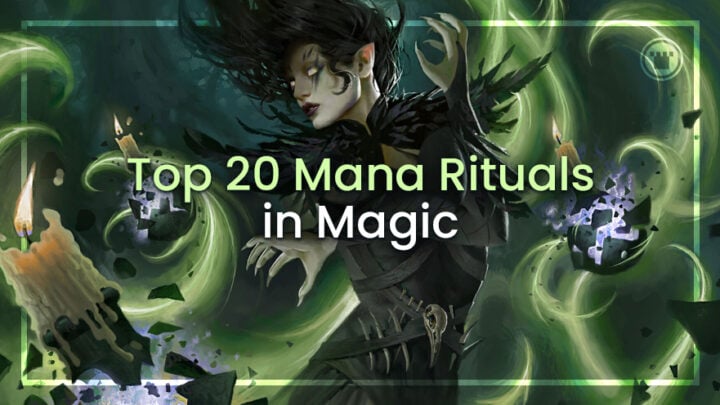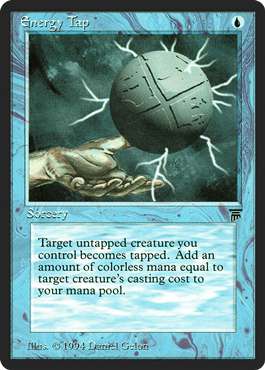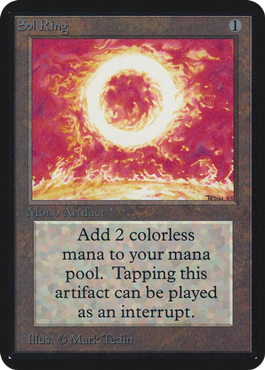Mana rituals! These distinctive, potent and strategically narrow cards are most often used to accelerate the endgame of combo decks. Perhaps due to that dangerous power, new rituals have become something of a rare sight in recent sets, no longer something Wizards of the Coast’s design team feels needs to feature prominently in Magic.
However, they are an elemental building block of the game, just like other early cards that offer a straightforward conversion of resources. We pay mana for cards all the time, and other spells always say something about the exchange rate of cards to mana. Compare the card-neutral Hammer of Bogardan to the otherwise-similar Lightning Bolt.

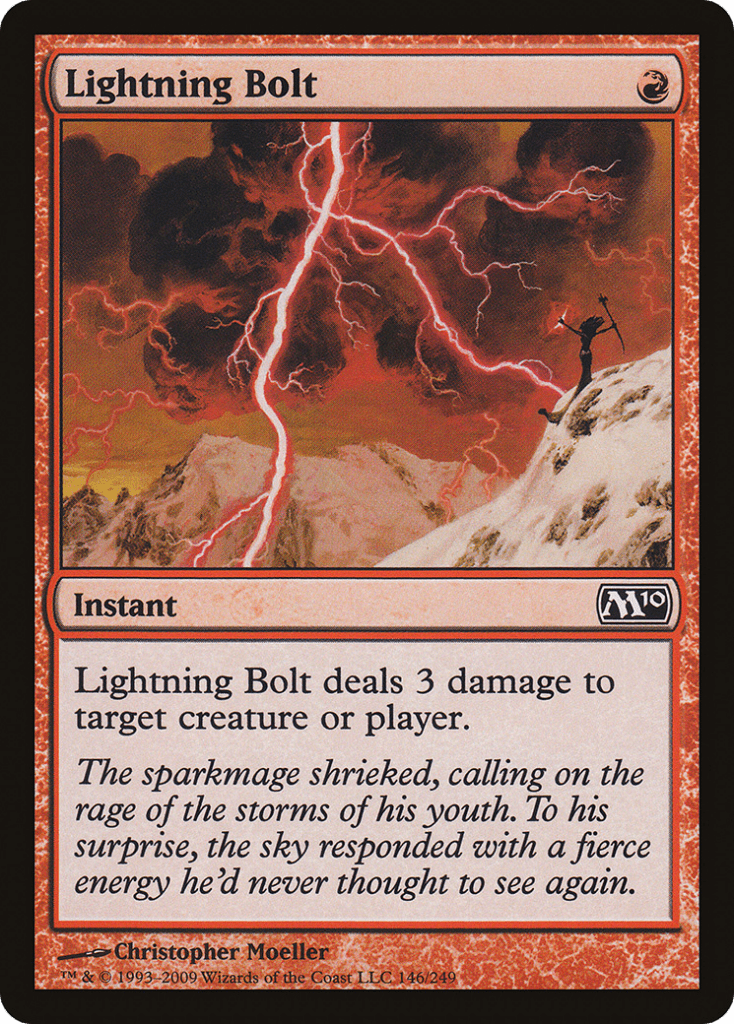
But mana rituals take this to the extreme, directly burning cards for mana in quantities that make Magic‘s most spectacular plays possible. Let’s go through the most potent and reliable enablers of the last 30 years:
20. GRIM MONOLITH
Not where you expected to start? It’s true that most of Magic’s iconic ritual effects are instants or sorceries, but is that all they can be?
For my purposes, any non-land effect that increases your available mana for the turn after you resolve it counts, and Grim Monolith certainly does that. It also leaves you around a permanent to sacrifice, and it also “unlocks” several bonus infinite combos with cards like Zirda, the Dawnwaker.
Oh, and if all else completely fails, I guess you can actually pay to untap it. Theoretically.
19. IRENCRAG FEAT
One of the most recent printings on the list, this was a pretty tough card to evaluate when it came out, and we’re only now starting to see it utilised more in various formats.
The restriction on Irencrag Feat neatly (if not so gracefully) prevents it from unbalancing ritual-loving decks like Storm by limiting what you can do with your mountain of mana. Instead, you should turn to this card when you want to just cast one specific, huge payoff — cards like Dragonstorm, Ugin, the Spirit Dragon, Soulfire Eruption or Deathbellow War Cry, for example.
18. RITE OF FLAME
This list is trying not to hone in on any one format, or even Constructed, as a metric for playability, but it is worth noticing which cards see consistent play in tournament decks when players are allowed them.
Rite of Flame may only produce a single net mana on the first cast, but if you’re able to cast a second copy, discard one away first or even somehow copy the card while leaving it in the graveyard, you can build the effect up into something quite powerful. That plus the low initial mana cost gets it onto the list.
17. ENERGY TAP
A lot of rituals are what I’ll call “situational,” meaning they require a little bit of set-up to reach their capacity in-game. The more elaborate groundwork necessary, the lower I rank them in the list.
Energy Tap is certainly playable, and the effect is a novelty in blue! But even at one mana, it’s a sorcery, only produces colorless mana and needs a large enough creature in play to use.
16. SOL RING
See everything I said about Grim Monolith, but better. It does only profit you one colorless mana the turn you play it, but it lets you keep a two-mana rock around for future turns… so it’s impossible to say if it’s good or bad?
Who am I kidding — you play this already. Moving right along…
15. METAMORPHOSIS
One of the rare green rituals on the list, Metamorphosis gets the nod for that exclusivity over arguably better option Burnt Offering. It also pays for its own casting cost AND can produce any color of mana, which the black versions of this effect don’t do.
A one-off Food Chain is sometimes all the Food Chain you need, especially if you already started the turn by cheating an arbitrary expensive monster into play for cheap!
14. INNER FIRE
Another conditional ritual, this one needs you to have five or more cards in hand (not including Inner Fire itself) to be worthwhile. Considering you also need to get up to a relatively hefty four mana to cast it, that seems like a pretty high bar for not much reward — but is it really?
We have to keep in mind what kinds of requirement ritual-focused combo decks are good at meeting. Drawing tons of cards is the most natural complement to playing rituals in the first place, as it lets you continue the chain of converting cards into mana and back again. And with no upper limit on hand size during your turn, a single Inner Fire following major draw effects can produce huge quantities of mana.
13. SONGS OF THE DEAD
Songs of the Dead is probably a little bit less of an easy box to check compared to Inner Fire, since creatures don’t usually feature heavily in the explosive combo decks where such rituals are required. But it makes it higher on the list thanks to its incredibly appealing mana value.
Even in a deck with just a handful of staple utility creatures, it does not take a lot of looting to turn this into a perfectly good two to three mana profit. The bar is so low, it’s practically six feet under!
12. SIMIAN (AND ELVISH) SPIRIT GUIDE

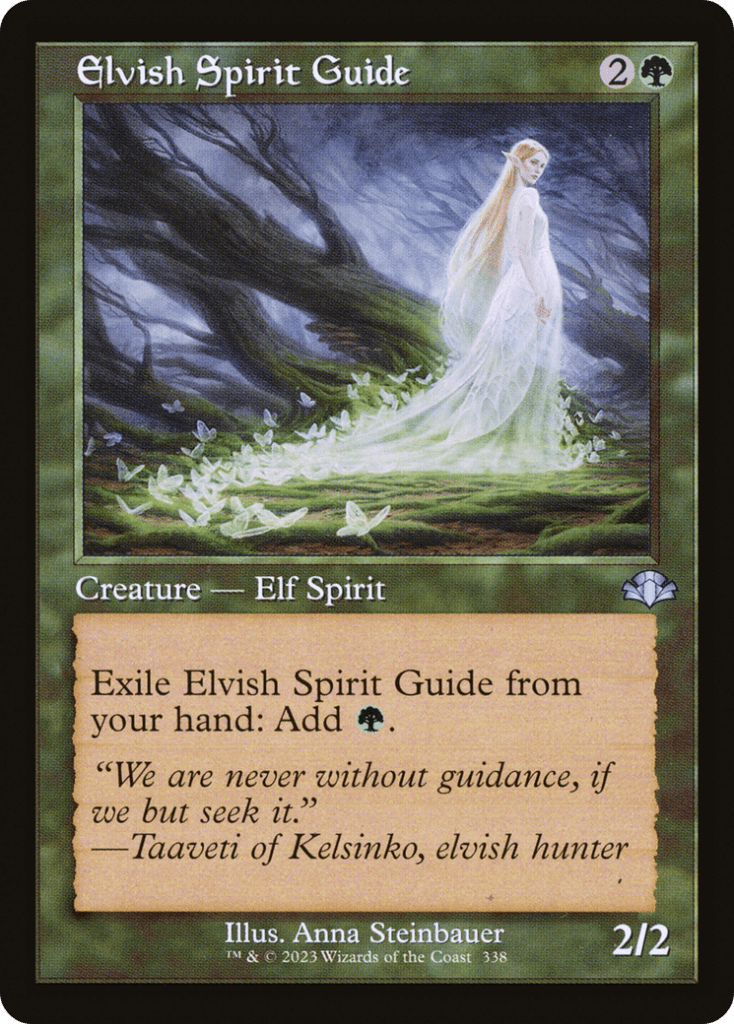
When we’re talking about the cards-to-mana exchange rate, generally the rituals that only profit you by one net mana aren’t good enough to make this list. In most contexts or formats, I would rather work slightly harder or meet some deckbuilding requirement to see a better per-card return.
But there’s a BIG exception here: rituals that get you from zero mana up to one mana. It’s hard to overstate how useful these can be given Magic returns us to zero mana after each step and phase.
These cards are the spark that ignites the bonfire. There are also quite a few archetypes where being able to cast the creature side to pressure an immobilized opponent is a crucial feature in favor of Simian Spirit Guide — and who among us cannot smile at that thought?
11. CULLING RITUAL
Culling Ritual is the kind of card that scales brilliantly with the power level of cards around it, gobbling up the cheap mana rocks, utility creatures and sideboard-hate cards that tend to accumulate in games of Legacy or Vintage.
It also scales with the number of players in the game, which contributes to its rising popularity in Commander. It’s certainly a soft counter to Treasure tokens, forcing a “use it or lose it” situation if opponents get too Dockside-happy.
But if you’re really focused on ritual potential, the best way to build around this card is to just play all the mana rocks and cheap junky permanents yourself, ramp into your own Culling Ritual and then convert a combo off the profits.
10. CABAL RITUAL
Showing the absolute sweet spot of risk and reward (at least for its time), Cabal Ritual has an “acceptable” worst case as a two-cost, one-profit mana ritual. But as discussed in support of Songs of the Damned, decks playing black rituals are generally quite proficient at loading up their yard.
And this time you don’t even need to be playing creature cards! Just get seven cards into the grave between cantrips, fetchlands and draw spells, and you’re suddenly netting three black per cast instead. That’s a 300% increase in mana profit!

9. LOTUS PETAL
So having established that artifacts can be rituals and that zero-cost rituals are among the most valuable kinds, we inevitably conclude that Lotus Petal is pretty good. Not exactly breaking news for those who enjoy Eternal formats — Tempest has been out for more than a quarter-century now!
Being a permanent, especially an artifact, gives it a number of advantages over the Spirit Guides. You can play it onto the field early to “hide” it from discard. It can passively benefit your other cards while waiting to be activated. And while it is only one use, this actually makes it easier to loop once you have a form of recursion.
The graveyard just becomes a round-about way to untap your mana source. When it comes to Black Lotus, we can officially say that one outta three ain’t bad.
8. CULLING THE WEAK
Culling the Weak is even more rewarding than Cabal Ritual, offering an unparalleled three-mana profit on your investment of a single black pip! Oh, sorry — one black pip PLUS your least-favorite creature. That part’s important.
Because while, yes, black decks are generally very good at making this sort of payment and, yes, creature tokens are not at all difficult to come by, the additional cost here is not optional.
There is no “acceptable floor” for Culling the Weak the way there is for Cabal Ritual. If you can’t pay, you can’t play, and that is a considerable drawback which keeps me from ranking this explosive card any higher.
7. TREASONOUS OGRE
Speaking of explosive cards with considerable drawbacks, non-Commander players might not have even heard of this card. They might also reasonably ask how a four-mana creature can be considered a “ritual” let alone one of the best rituals in Magic. Well, the answer is “twenty extra starting life,” almost guaranteeing that this Ogre can pump out five to seven mana on the spot.
Even without discounting or cheating it out to change the math, that’s a solid exchange — and if you have any way to recoup the life then you’re off to the races. You have to actually gain life, though; it’s one of those Magic corner cases that you can’t go below zero life to pay costs, even if it wouldn’t kill you.
6. MANA GEYSER
This one is more or less a Commander-only special; but boy, is it a special one. Not only does having three or more opponents considerably increase the ceiling on the return here, but the proactive nature of multiplayer games makes it more likely that those opponents will be tapping out (at least outside of cEDH power levels). Of course, you can always help things along a little if you think your opponents aren’t offering you the right opportunity.
5. DARK RITUAL
We’ve arrived at the OG ritual, and thankfully it still holds up as a premium example of its kind. One black mana + one card = three black mana. It’s a beautiful and game winning equation that has powered a shocking number of different plays over the years.
Aside from the still-excellent return, it’s the versatility that has Dark Ritual ranked so high. One black mana is such a low barrier to entry that this card finds its way into all sorts of lists that could never justify other spells mentioned. Reanimator, Depths, Doomsday, Chalice of the Void decks, basically every black commander — Dark Ritual is still an offer no self-respecting black mage can refuse.
4. JESKA’S WILL
The signature mana ritual of Commander (at least the one that doesn’t rely on your opponents’ artifact count) is as good as advertised. Ramping this out early reliably lets you get seven red back, if not more.
Assuming you get your commander into play first, it also turns into its own follow-up draw spell. Even the worst-case scenario of “only” using it to impulse draw is an effect you’d be happy to run on its own.
What more can you say? Some spells are simply built different.
3. ANY MOXEN
If Lotus Petal was good enough to make it to the top ten, how good is a reusable Lotus Petal going to be? Un-reprintably good, as it turns out.
A solid portion of Magic players will never get to cast an original Mox since they’re prohibitively expensive and also literally prohibited in most formats. But suffice it to say they are game-defining little chunks of efficiency, not just for their own mana production but for their natural synergies with everything from Monastery Mentor to Paradoxical Outcome to Winter Orb.
Even the (relatively) cheap and legal thrills of Mox Diamond, Chrome Mox, Mox Opal and Mox Amber are good enough to hold this hallowed spot on the list.
2. CHANNEL
Even colorless mana production can be busted if you make it free! Channel is, of course, the OG broken combo enabler, used since the earliest days of Magic playtesting to power out lethal Fireballs. Its power and iconic status has never faded despite it being banned basically everywhere and, understandably, not receiving the kind of soft-reprints that the Mox concept did.
I think that cultural cachet speaks to the compelling flavor of the spell. After all, what’s more iconically wizard-y than the Faustian pact, sacrificing life force for short-term gain? Anyway, if you want to see what Channel decks look like in 2023, check out Vintage Oath or the occasional 7-Point Highlander list.
1. BLACK LOTUS
How could arguably the best card of all time not also be the best mana ritual? I’d love this to be some kind of epic, last-minute twist, but there’s no arguing with the numbers on Magic’s poster child.
Black Lotus combines the accessibility of a Spirit Guide, the flexibility of Dark Ritual, the synergies of the Moxen and the profitability of a full-powered Cabal Ritual with no setup required. It’s literally three times as good as Lotus Petal and has even easier recursion loops thanks to its explosive mana production.
Of course, Black Lotus is such an absurd outlier that it was essentially blackballed out of the game less than a year after Magic’s release. Wizards of the Coast immediately realized that allowing it to remain prominent would destroy the whole concept of the mana-cards exchange rate, something fundamental to the game’s future balance.
Despite all the love that many bear for this beautiful card, and all that it means to Magic to this day, Black Lotus is literally too good for this world. It shall remain in its Vintage containment zone forevermore.
FIZZLING OUT
So ends our quick countdown of Magic’s fastest mana. We may never see the likes of Channel or Black Lotus again, but new Commander sets are sneakily adding mana rituals all the time, and even a relatively playable Irencrag Feat or Apex of Power can slip into Standard from time to time.
That said, there may just not be a need for that many more cards to exist in this rather narrow design space — and that’s perfectly alright. The mana rituals we have now have served players well for years. And now, with this guide to follow, you can put them to work for your decks, too!

Tom’s fate was sealed in 7th grade when his friend lent him a pile of commons to play Magic. He quickly picked up Boros and Orzhov decks in Ravnica block and has remained a staunch white magician ever since. A fan of all Constructed formats, he enjoys studying the history of the tournament meta. He specializes in midrange decks, especially Death & Taxes and Martyr Proc. One day, he swears he will win an MCQ with Evershrike. Ask him how at @AWanderingBard, or watch him stream Magic at twitch.tv/TheWanderingBard.

